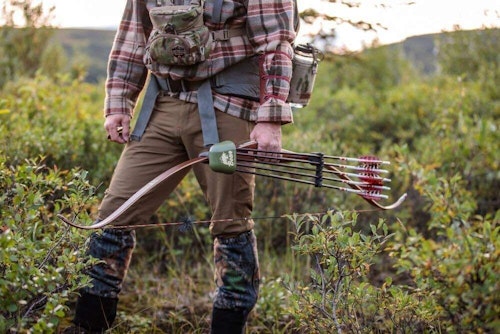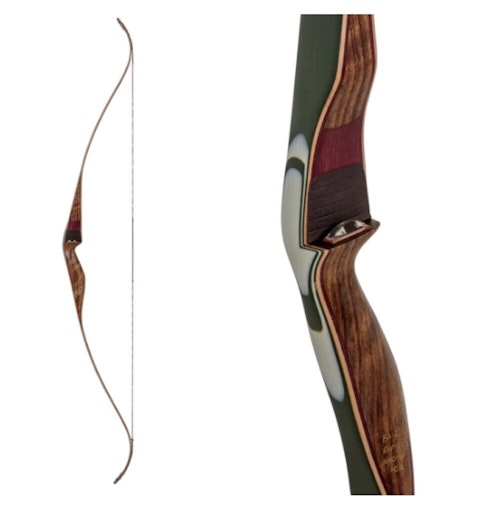Even though the vast majority of your customers shoot compounds, it makes sense to stock some traditional gear, specifically recurves. A few longtime compound shooters might want the added challenge of “going traditional,” while others might want to simply buy a trad bow because it’s so fun to shoot, even though they don’t plan to hunt with it, at least not yet.
The good news for dealers is you don’t have to go crazy and stock a wide variety of recurves to get into the game. Draw length is a non-factor; the only specs you must consider are draw weight, length and price.
Inventory and Selling Tips
Compound shooters who draw 70 pounds will struggle mightily when trying to draw a 50-pound recurve. At full draw (assuming 80 percent let-off), a 70-pound compound requires the shooter to hold only 14 pounds. Of course, the poundage increases as you pull back a recurve, with the maximum weight achieved at full draw. In addition, compound shooters rely on a release, while they’ll have to use a finger tab or glove with a recurve. Their fingers will tire quickly when drawing and shooting a 50-pound recurve.
For this reason, it makes sense to stock recurves that customers can draw and aim much easier. At distances of 20 yards and less, a 35- or 40-pound-draw recurve is deadly on whitetails. Do your best to convince hunters who are interested in going traditional to avoid the mistake of buying — and drawing — too much bow. Drawing too much weight will result in poor technique, and poor accuracy. If you stock only three recurves for hunters to try on your shooting lanes, go with 35, 40 and 50 pounds. Let them feel the difference. If they can set aside their ego, they should make the smart decision and buy a 35- or 40-pound recurve.
Almost all compound shooters today, at least those under the age of 55, have no experience with a long-axled bow. Today, a hunting compound measuring 33 inches is considered long, and most target compounds measure 36 or 38 inches. This is why a release is mandatory. There’s zero chance of accurately shooting a modern compound with fingers on the string due to finger pinch.
Short recurves can also have a bit of finger pinch, especially for shooters with long draw lengths. For this reason, it’s best to stock recurves measuring at least 58 inches in length. In terms of finger pinch, a 60-inch bow will feel more comfortable than a 58-incher, and a 62-incher will feel even better than a 60-incher. You get the idea.
Below you’ll see my three suggestions for dipping your toe in traditional waters. The price points vary from $550 to $830. Could you stock cheaper models? Sure. But the bows listed here — all from Bear Archery — should provide a lifetime of dependable performance, and if taken care of, could be handed down to a son or daughter who wants the thrill of hunting with a recurve.
Bear Super Grizzly ($549.99; 58 inches; one piece)
The original Super Grizzly recurve was available in the mid-1970s, and this modern version was introduced in 2011. The Super Grizzly’s smooth performance is largely the result of two layers of lamination in the limbs, creating a better-feeling, better-shooting recurve bow without hand shock. Features include: double layer maple laminate limbs backed and faced with high-strength black fiberglass; crowned, cut-on center arrow shelf with leather side plate and bear hair arrow rest; Dynaflight 97 Flemish Twist string included; reinforced tip.
Bear Kodiak ($729.99; 60 inches; one piece)
The 1959 Kodiak was an iconic bow in the Bear lineup, and fans of the model have asked for its return for decades. Those hunters got their wish when the company announced a new iteration of the legendary Kodiak with a reintroduction in 2022. The new Kodiak showcases several improvements, including a beautiful shedua riser with purple heart inlay and stunning green glass limbs. The Kodiak is 60 inches long, making it an excellent choice for any hunting scenario or backyard target shooting. Features include: shedua riser with inlaid purple heart and green glass; limb cores made with maple laminate and overlaid with high-strength green fiberglass; crowned, cut-on center arrow shelf with leather side plate and iconic feather arrow rest; Dynaflight 97 Flemish Twist string included.

Bear Mag Riser ($399.99) With Take-Down Limbs ($429.99; 56- to 64-inches total length)
When it comes to a take-down recurve, it’s hard to beat the classic Fred Bear design. Of all the recurves in the Bear lineup, this is my personal favorite. The reason is it shoots like a dream — buttery smooth on the draw, smooth on the release, quiet and accurate. The all-new Mag Riser is built from cast aluminum, and has a comfortable molded wrist-style grip.

As for recurve length: The A riser is 4 inches shorter than the B riser, which obviously changes the total length of the bow after choosing take-down limbs. Specifically, you can match an A riser with #1 limbs to make a 56-inch bow, #2 limbs to make a 58-inch bow, or #3 limbs to make a 60-inch bow. The B riser can be paired with #1 limbs to make a 60-inch bow, #2 limbs to make a 62-inch bow, or #3 limbs to make a 64-inch bow. After shooting a few options at a couple of ATA Shows, I finally decided on a style A Mag Riser matched with #3 limbs, so my finished recurve is 60 inches long.
Mag Riser plus Take-Down Limbs features include: aluminum riser for extreme accuracy and durability; famous Fred Bear take-down system for easy transportation; riser includes bushing for stabilizer and quiver accessories; adjustable center shot side plate allows for perfect arrow tuning; limbs are constructed of layered hard rock maple and black fiberglass; handcrafted tips are reinforced with black-and-white fiberglass to accommodate modern strings; 56- to 64-inch configuration.
Final Thoughts
If you stocked these three bows, and shot them side by side to conduct a “feel” comparison, I suspect you’d agree with these statements: All three are good shooters, but the longer Kodiak is just a touch smoother than the Super Grizzly. Regardless of configured length with a Mag Riser and Take-Down Limbs, this combo is the smoothest shooter of them all. And although I’m far from a traditional bow expert, I think a big part of it is the Mag Riser’s additional weight, in addition to the riser material (cast aluminum).
I really had my heart set on getting a one-piece all-wood recurve, but when I finally shot the Mag Riser/Take-Down Limbs combo at the ATA Show, and compared its performance to all other recurves that the Bear Archery staff brought to the event, I just couldn’t deny the results.









